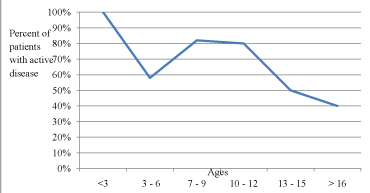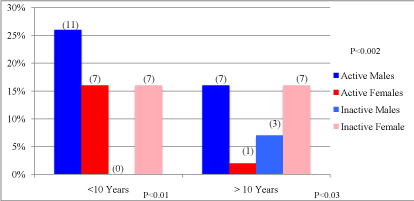Department of Pediatrics, NYU Langone Medical Center, USA
*Corresponding author: Trachtman H, Department of Pediatrics, Division of Nephrology, NYU Langone Medical Center, 227 E. 30th Street, Room 110, New York 10106, USA
Received: September 17, 2014; Accepted: October 28, 2014; Published: October 30, 2014
Citation: Chwat J, Kikov E, Rozenbaum M, Vento S, Malaga-Dieguez L and Trachtman H. Predictors of Persistent Disease Activity in Childhood Minimal-Change Nephrotic Syndrome. Austin J Nephrol Hypertens. 2014;1(5): 1023.
Citation: Bucci J and Hansen KE. Should we treat Secondary Hyperparathyroidism in Patients with Pre-Dialysis Chronic Kidney Disease?. Austin J Nephrol Hypertens. 2015; 2(4): 1046. ISSN : 2381-8964
Minimal Change Nephrotic Syndrome (MCNS) is a disease of childhood that follows a relapsing course but does not cause chronic kidney disease. The primary objective of this single center, retrospective chart review was to determine if there is an age beyond which patients with MCNS are more likely to achieve long-term remission. The secondary objective was to identify risk factors that can predict prolonged disease activity. The records of 43 children with MCNS were reviewed and the following data were tabulated: gender, age at diagnosis, age at last follow-up, duration of disease, medications used to treat MCNS, and the disease activity at last follow-up. In the full cohort of patients, there were 18 males and 8 females with active disease and 3 males and 14 females with inactive disease (P<0.002). In patients <10 years old, there were 11 males and 7 females with active disease and 0 males and 7 females with inactive disease, (P<0.01). In patients ≥10 years there were 7 males and 1 female with active disease and 3 males and 7 females with inactive disease (P<0.03). Over the full age spectrum, males were more likely to have active disease. There was no specific age at which the relapse frequency decreased significantly. There was no significant relationship between gender and activity of disease when comparing patients on MMF, tacrolimus, and rituximab, but there were 3 males and 1 female with active disease and no males and 6 females with inactive disease on prednisone alone (P<0.05). We conclude that there is no discrete age at which pediatric patients with MCNS are more likely to go into extended remission. Moreover, at any age, compared to boys, girls are more likely to go into long-term remission without requiring steroid sparing therapy.
Keywords: Minimal change nephrotic syndrome; Natural history; Gender; Relapse
FRNS: Frequently Relapsing Nephrotic Syndrome; ISKDC: International Study of Kidney Disease in Children; MCNS: Minimal- Change Nephrotic Syndrome; MMF: Mycophenolate Mofetil; SDNS: Steroid Dependent Nephrotic Syndrome
Minimal Change Nephrotic Syndrome (MCNS) is the most common form of Nephrotic syndrome in children. Most nephrologists inform parents that patients are likely to go into long-term remission around the age of puberty. However, it is well known that 30% of patients with MCNS present in adolescence. Studies on the natural history of this disease have shown that patients can continue to relapse 10-15 years after the onset of the disease [1]. However, no previous report has defined a cutoff age when the likelihood of continued relapses drops off significantly.
Many factors have been found to predict the likelihood of a child relapsing as he/she gets older. Children whose diseases presents before the age of 6 have a greater risk of relapsing into adulthood than those who were diagnosed at an older age [2]. In addition, having many relapses as a child indicates an increased risk of relapsing later in adolescence [3]. Lastly, there is an inverse relationship between duration of treatment and risk of relapses [4]. We conducted this retrospective review to determine if there was a specific age at which pediatric patients with MCNS achieve long-term remission. Our secondary objective was to define risk factors other than age that are associated with an increased risk of prolonged active disease.
This was a single center, retrospective chart review of all children and adolescents with MCNS who were followed at the Fink Center of NYU Lang one Medical Center or Bellevue Medical Center between January 2012 and July 2014. MCNS was diagnosed based on steroid responsiveness, defined as achieving a complete remission of proteinuria (urine dipstick test result negative or trace for 3 consecutive days) in response to a standard course of prednisone. The diagnosis of MCNS was not based on performance of a kidney biopsy. Charts were reviewed and the following data were tabulated: gender, age at the time of diagnosis, age at last follow-up visit, duration of the disease, medications prescribed to treat MCNS, and the status of the disease at last follow-up evaluation.
Active disease was defined as having a relapse within a year of the last follow-up visit and inactive disease was defined as not relapsing within a year of the last follow-up visit. This definition was an arbitrary one but it was based on the practice at our center to follow children with MCNS until they had been in continuous remission for one year. Infrequent relapsing, Frequent Relapsing (FRNS), and Steroid Dependent Nephrotic Syndrome (SDNS) were defined as per the ISKDC [5].
Data was reported as mean+Standard Deviation (SD). Continuous variables were compared using the t-test and categorical variables were compared using the Chi Square or Fisher exact test where appropriate. Results were considered significant if P< 0.05.
43 pediatric patients diagnosed with MCNS were included in this retrospective review. There were 21 males (49%). The mean age at the diagnosis of the disease was 6.4+4.9 years and was comparable in those younger or older than age 10 years at last follow-up (P>0.1). The average duration of the disease was 36.4+29.1 months. At last follow-up visit, 39 children (91%) were taking prednisone, 18 (42%) were on Mycophenolate Mofetil (MMF), 15 (35%) were on tacrolimus, and 3 patients (7%) had been given rituximab to treat their disease. 26 patients (60%) had currently active disease, while 17 (40%) had inactive disease.
There were 25 children under the age of 10 at last follow-up visit. In this group, there were 11 (44%) males. The age at the diagnosis of the disease was 3.5+1.7 years. The duration of disease was 27.2+18.4 months. At last follow up visit, 23 (92%) patients were on prednisone, 13 (52%) were taking MMF, 6 (24%) were on tacrolimus, and 2 (8%) had been given rituximab. In contrast, there were 18 children age > 10 years at their last clinic assessment; 10 (56%) were males. The age at the time of the diagnosis was 10.4+4.9 years. The duration of the disease was 48.2+27.9 months. At last follow-up visit, 14 (78%) children were taking prednisone, 8 (44%) were on MMF, 8 (44%) were taking tacrolimus, and 1 (6%) had been given rituximab (Table).
In the group as a whole, there was a fairly steady percentage of patients with active disease regardless of age at last follow-up (Figure 1). There were 18 males and 8 females with active disease and 3 males and 14 females with inactive disease (P<0.002). In patients under the age of 10 years, there were 11 males and 7 females with active disease and 0 males and 7 females with inactive disease, (P<0.01). Lastly, in patients ≥ 10 years there were 7 males and 1 female with active disease and 3 males and 7 females with inactive disease (P<0.03) (Figure 2). Thus, across the age spectrum, male patients were more likely to have active Nephrotic syndrome. There was no difference in the percentage of children with FRNS/SDNS in children under the age of 10 years(33%) and in children >10 years (38%).
There was no significant relationship between gender and activity of disease when comparing patients on MMF, tacrolimus, and rituximab. The only medication with a significant relationship between gender and disease was prednisone. There were 3 males and 1 female with active diseases and no males and 6 females with inactive diseases on prednisone alone (P<0.05). This suggests that females with MCNS are more likely to have extended control of the nephrotic syndrome on prednisone and not require steroid sparing therapy.
Most nephrologists claim that children go into permanent remission around the time of puberty, but usually do not cite a specific cutoff age. Based on our findings, there appears to be a continuum of disease activity throughout the pediatric age range and there was no evidence for a specific age that predicts entering into long-term remission. Our data do not support spontaneous resolution of MCNS at puberty.
The secondary goal of this study was to define factors that increase the likelihood of having an active disease. The only factor found to have impact on the risk of persistent relapsing status was gender. Over the entire age spectrum, males were more likely to have active MCNS than females. Upon examining the relationships between gender and activity of disease when comparing patients on MMF, tacrolimus, and rituximab no significant relationship was observed. Contrary to previous literature, our findings do not support a correlation between medications and course of MCNS. Rather, it shows that specific treatments do not have effects on the course of the disease. However, it was found that more females taking prednisone had inactive disease than males. This suggests that females are more likely to have adequate control of the nephrotic syndrome with prednisone alone and not require steroid sparing therapy.
Others studies have shown a higher incidence of MCNS and a greater likelihood of frequently relapsing disease in boys [6]. However, this is the first report to highlight the risk of persistently active disease in all age subgroups in boys. The course of MCNS in males leads them to have a greater risk exposure to steroid sparing treatment. Second-line treatment with cyclophosphamide can result in gonadal failure in males and decrease in sperm production. This is less of a problem in girls since the oocytes are less susceptible to drug effects. Although males are more likely to have MCNS, no studies have explained why males are more likely than females to have more prolonged disease activity at all ages.
This study had several limitations. Since it was a single-center retrospective chart review, the study was limited in size and its generalizability is open to question. In addition, we could not examine the extended relationship between age at the onset of MCNS and risk of relapsing later into adolescence because this study only involved follow-ups up to July 2014.
There is no specific age at which relapsing significantly decreases. Over the entire age spectrum, males were more likely than females to have persistently active disease and females are more likely to have adequate control of MCNS by taking prednisone alone and do not require steroid sparing therapy.
The percentage of patients MCNS who had active disease by age at last follow-up.

The percentage of patients with active disease divided by gender and age at onset of MCNS.
